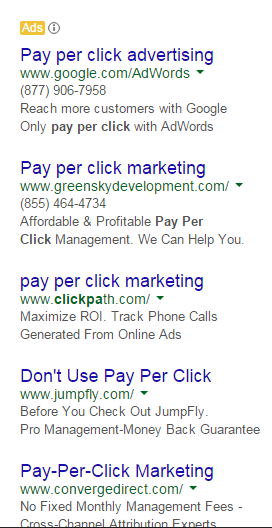Employing online advertising techniques, such as Google AdWords, can provide a significant boost to your website traffic while you are working to optimize for organic search results through inbound marketing.
Google AdWords or Pay Per Click marketing is a form of internet advertising based on keywords you believe your target market is using to search for your products or services online. As an example, The Marketing Department, a full service advertising agency located in Malvern, PA would assume potential customers could be searching with keywords such as Marketing Services, Web Design, Graphic Design and Inbound Marketing. There are several hundred searches a month on general keywords like these, however larger marketing companies with greater search marketing budgets create a very difficult landscape for local marketing agencies to make waves at the top of a search engine results page. A general rule that exists in Pay Per Click marketing is the more broad and general a keyword is, the more difficult it becomes to compete for or, in search terms, rank for.
Essentially, Google AdWords works as an auction system in which you buy the rights to a keyword or keyword phrase. When these keywords are typed into a search engine it creates an opportunity that your ad and website will be featured on the first page of the search engine results.
The goal is to choose the correct keywords that target your potential customers. A strong keyword analysis determines the best keyword options for your target audience.
A keyword analysis focuses on 3 core components of a keyword
- The Average Monthly Searches in a selected geography. Within a selected geography, Google’s keyword planner provides the monthly average searches a specific keyword has been searched for over the past 12 months.
- Cost of the suggested bid – The amount of money that you need to bid to achieve the optimal position and click through rate for that keyword.
- The Competition for that keyword- a given assessment on how many other competitors are bidding for that keyword at a given time. The competition is a measurement of the opportunity a keyword has to attract traffic to your web page.
We at The Marketing Department believe that the best AdWords strategy for small to medium sized businesses is to focus on moderately long tail keywords (2 to 5 words) with low cost and low competition. Keywords that fall into this category will be more effective than highly competitive keywords. Below is an example of three general keywords, PPC, Graphic Design, web design and there results in the Chester County, PA area.

The 3 keywords have a high competition rating and high average monthly searches. There exists more of an opportunity to draw traffic from longer search terms with low competition for example.

“Advertising Techniques” receives about 10 searches a month in Chester County, has a low competition ranking and the suggested bid is significantly lower than the 3 example keywords above. This means that, when clicked, the keyword “Advertising Techniques” will only cost $2.66 as compared to “Web Design” that would cost $21.37 for a click in a saturated market with high competition. There is a much more cost effective opportunity to rank for “Advertising Techniques” than “Web Design.” It is easy to imagine, over the course of a yearlong AdWords campaign, how these keyword and bidding cost differences can add up.
It is better to target low competition keywords that target prospects looking for something more specific. Bidding on these keywords presents more of an opportunity to receive paid traffic and top of the page position ranking, as compared to side ad (right column) position rankings when Google delivers the search results. This strategy enables cost efficient and effective website traffic development, and allows small companies to compete with larger national companies and gain web traffic under the radar of their larger search campaigns.


What Keywords Do I choose?
A great way to select the optimal keyword for your campaign is to use Google’s keywords tool. Type in 10 to 15 of the general keywords that are relevant to your industry or field of work and review the 700 – 800 other keywords google has suggested. Target the keywords that receive respectable average monthly searches, have low or medium competition and a suggested bid within your budget.
The Structure of a AdWords Campaign
Related keywords are typically grouped into their own ad groups. For example “Web Design” and “Website Design” would reside in the same ad group with the same ad. Each ad group is linked to an ad with messaging related to that ad group’s keywords. A Google ad may have 5, 6 or 100 keywords associated with it.
Remember, that your keywords and your ads need to be relevant to one another. Your paid search campaign can be penalized by the search engines if your keywords corresponding ad have nothing to do with one another. Ad relevance is a significant contributing factor in your ad ranking position on the search results page. Try to keep the amount of keywords connected to your ad at a minimum to keep your campaign relevant.
AdWords Terminology
An Impression is created each time a keyword is searched and that keyword’s corresponding ad is shown on the search results page.
A Click or Click Through is counted each time a keyword is searched and that keyword’s corresponding ad is clicked by the reader of the respective ad.
The Click Through Rate (CTR) for a keyword is the number of Clicks divided by the number of Impressions. Click through rate or CTR measurements exists at the single keyword level, ad group level and campaign level of a paid search campaign. Click through rate is the tell-tale statistic for the success of the campaign. An industry standard in paid search marketing is to achieve a 1% CTR at the campaign level. Everything above 1% is considered a successful campaign.
An AdWords campaign starts with defining the keywords for the targeted market, followed by A/B testing to determine which keywords are performing best. The testing is tracked, tweaked and optimized during the testing phase of an ad campaign. It is a very difficult task to select the perfect keywords relevant to the perfect ad that is relevant to the perfect landing page (the web page your ad is linked to). You can think of the beginning of your campaign as trying to make an educated guess at what your potential customers are asking the internet. Yet, over time, you will begin to gather data and become more knowledgeable about what keyword terms, ads and landing pages are bringing in traffic.
Once all keywords, ad(s) and landing page(s) are optimized and remain contextually relevant, the search campaign should begin to yield the optimal results with high ad position rankings. The ultimate goal is to stay financially efficient and contextually consistent throughout all levels of your Pay Per Click campaign. If these Pay Per Click practices are strong within your campaign, the advertising investment will bring in a largely positive return.

_(1).png?width=190&height=84&name=TMD_LOGO_338x149_(web)_(1).png) The Marketing Department Malvern, PA is a full service Marketing Agency serving Malvern, Main Line, King of Prussia, Wayne, Paoli, Berwyn, Chester County and Montgomery County, PA areas.
The Marketing Department Malvern, PA is a full service Marketing Agency serving Malvern, Main Line, King of Prussia, Wayne, Paoli, Berwyn, Chester County and Montgomery County, PA areas.